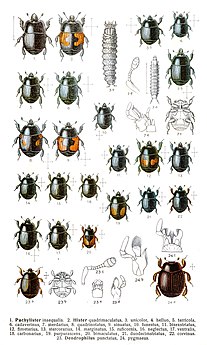
The acouchis are rodents belonging to the family Dasyproctidae from the Amazon basin. They are generally smaller than agoutis and have very short tails, while agoutis lack tails. For this reason the acouchis are also called tailed agoutis.

Leucochloridium paradoxum, the green-banded broodsac, is a parasitic flatworm that uses gastropods as an intermediate host. It is typically found in land snails of the genus Succinea that live in Europe and North America, where it infects the host’s eyes, making them appear as caterpillars or maggots. Birds eat them, becoming a host for L. paradoxum to mature and release eggs in the rectum, which are later excreted in the feces of the bird host.

The Encyclopedia of Life (EOL) is a free, online collaborative encyclopedia intended to document all of the 1.9 million living species known to science. It is compiled from existing databases and from contributions by experts and non-experts throughout the world. It aims to build one "infinitely expandable" page for each species, including video, sound, images, graphics, as well as text. In addition, the Encyclopedia incorporates content from the Biodiversity Heritage Library, which digitizes millions of pages of printed literature from the world's major natural history libraries. The project was initially backed by a US$50 million funding commitment, led by the MacArthur Foundation and the Sloan Foundation, who provided US$20 million and US$5 million, respectively. The additional US$25 million came from five cornerstone institutions—the Field Museum, Harvard University, the Marine Biological Laboratory, the Missouri Botanical Garden, and the Smithsonian Institution. The project was initially led by Jim Edwards and the development team by David Patterson. Today, participating institutions and individual donors continue to support EOL through financial contributions.

Diplozoon paradoxum is a flatworm (platyhelminth) from the class Monogenea found in freshwater fishes in Asia and Europe and known for its complete monogamy. This parasite is commonly found on the gills of European cyprinid fishes. It is usually around 0.7 centimeters long and has bilateral symmetry. It has several hooks at its mouth which it uses to grab on to the gills of a fish. From there it feeds on the blood of a cyprinid.

Polyopisthocotylea is a subclass of parasitic flatworms in the class Monogenea.
Botrychium paradoxum is a species of fern in the family Ophioglossaceae known by the common name peculiar moonwort. It is native to North America, where there are scattered occurrences in Alberta, British Columbia, Saskatchewan, Montana, Oregon, Utah, Washington, and Wyoming.

Allium paradoxum, the few-flowered garlic or few-flowered leek, is an Asian species of wild onion in the Amaryllis family. It is native to mountainous regions of Iran, Caucasus, and Turkmenistan.
Penicillium paradoxum is a species of fungus in the genus Penicillium.. Penicillium paradoxum grows on dog dung and is phototropic, and has a characteristic odour. Unusual for Penicillium, the fungus has an Aspergillus-like conidial head, not a penicillus.
Omosarotes paradoxum is a species of beetle in the family Cerambycidae. It was described by Tippmann in 1955. It is known from Panama, Ecuador, and Peru.
Morimospasma paradoxum is a species of beetle in the family Cerambycidae. It was described by Ganglbauer in 1890.

Diplozoidae is a family of monogeneans in the order Mazocraeidea. In all species of this family, the bodies of the two hermaphroditic members of a couple are permanently fused for life. These monogeneans are parasitic on the gills of freshwater fish.

Ozophora is a genus of dirt-colored seed bugs in the family Rhyparochromidae. There are more than 100 described species in Ozophora.
Peripsocus is a genus of stout barklice in the family Peripsocidae. There are more than 250 described species in Peripsocus.

Hoplitis is a genus of bees in the family Megachilidae. There are more than 380 described species in Hoplitis.
Teretriosoma is a genus of clown beetles in the family Histeridae. There are about 11 described species in Teretriosoma.

Teretriini is a tribe of clown beetles in the family Histeridae. There are about 5 genera and more than 90 described species in Teretriini.

Exechia is a genus of fungus gnats in the family Mycetophilidae. There are more than 180 described species in Exechia.

Atomaria is a genus of silken fungus beetles in the family Cryptophagidae. There are more than 160 described species in Atomaria.
Stylurus spiniceps, the arrow clubtail, is a species of clubtail in the dragonfly family Gomphidae. It is found in North America.
Teretriosoma chalybaeum is a species of clown beetle in the family Histeridae. It is found in Central America and North America.













